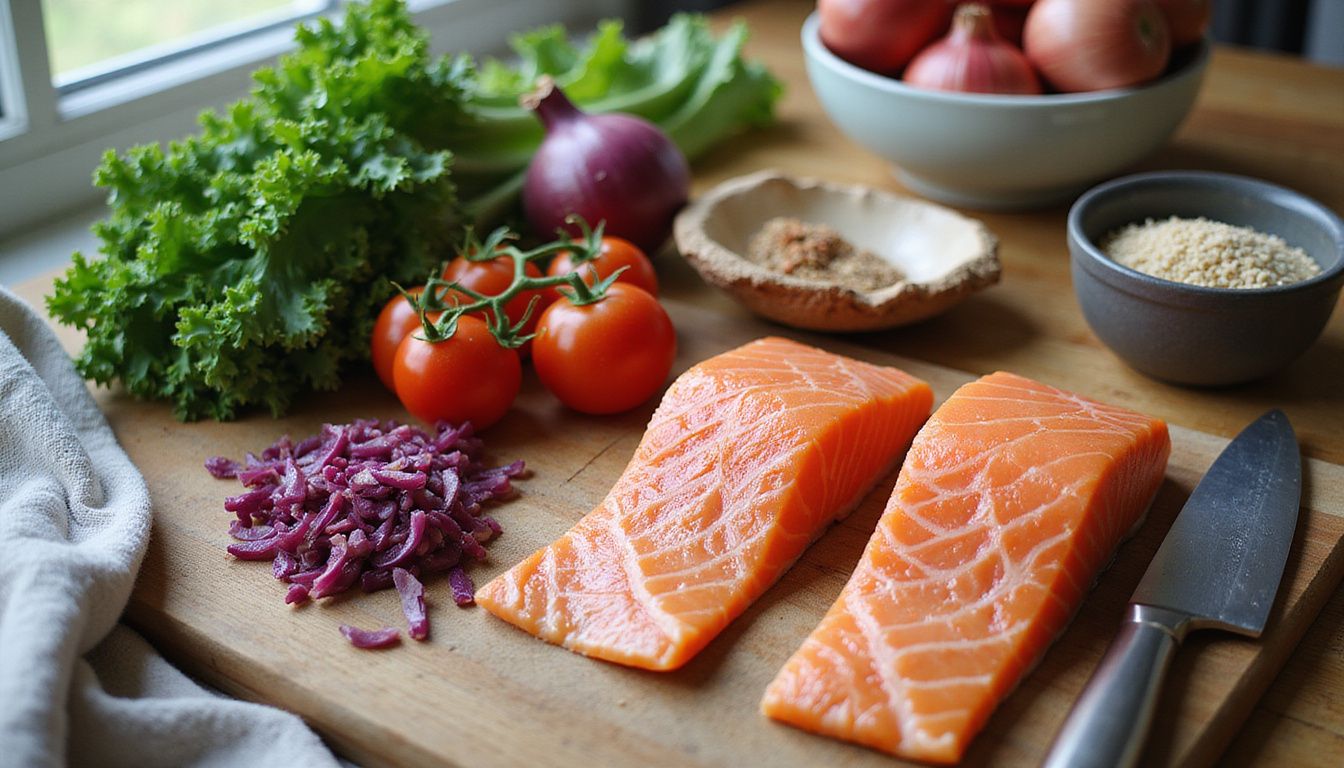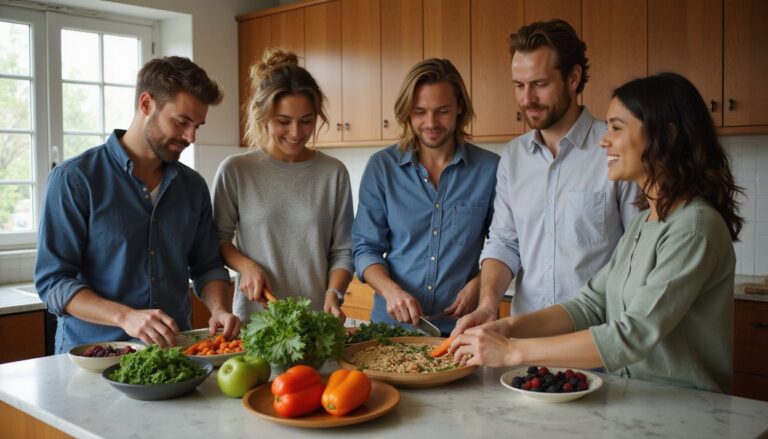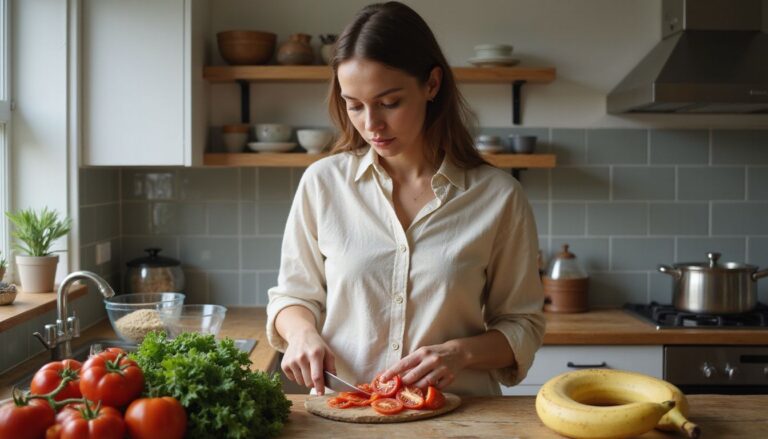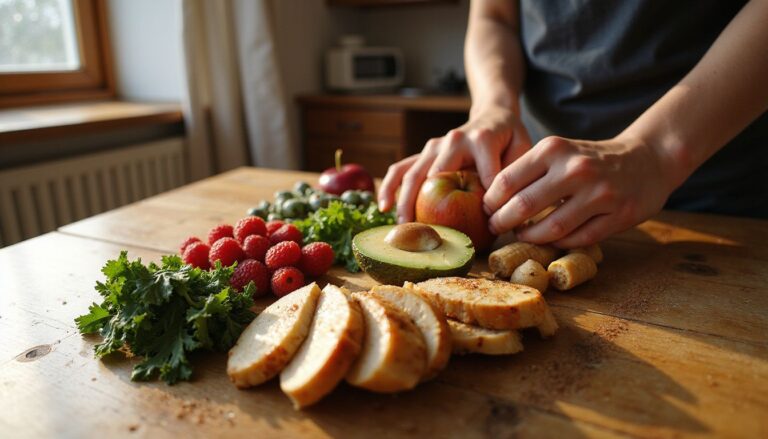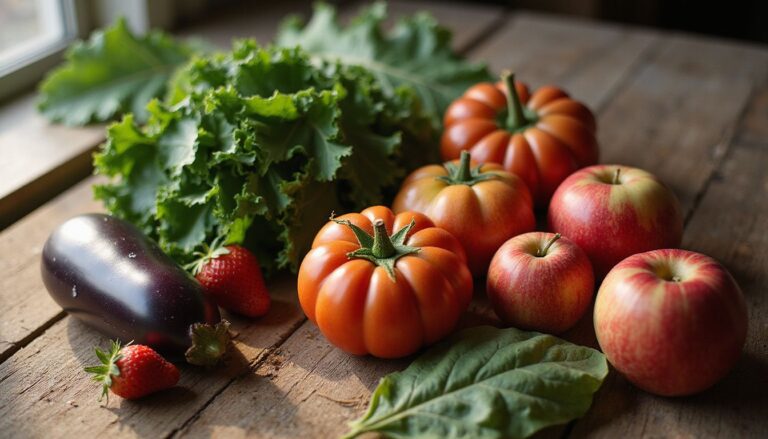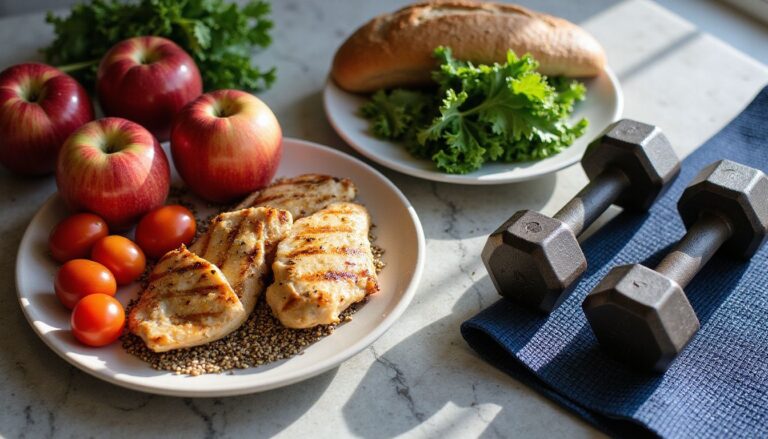Effortless 7-Day High-Protein Meal Plan For Weight Loss
Our Nutrition Assistant AI Suite will transform your body. You will lose fat, get toned, and build muscle. Gain confidence and optimal health.
Weight loss can feel confusing when meals are a guess. A high-protein meal plan can cut hunger, protect muscle, and make daily choices simple. This 7-day plan gives you clear meals, easy prep, and steady progress.
This 7 Day Protein Diet Plan For Weight Loss focuses on lean protein, vegetables, whole grains, and simple recipes. You will see how a structured week reduces decision fatigue and supports your goals with less stress.
Learn how a high-protein diet can help you lose fat with more confidence and fewer cravings.
Key Takeaways
- This 7-day high-protein meal plan targets at least 80 grams of protein and 30 grams of fiber each day to support fullness and muscle during weight loss.
- Daily calories stay near 1,400 to 1,600 for steady fat loss in most adults.
- Each day includes lean protein such as chicken, salmon, eggs, strained yogurt, beans, or tofu, paired with whole grains and vegetables for balance.
- Batch cooking and smart meal prep reduce hunger, save time, and cut recipe stress.
- Research from Leidy HJ et al., AJCN 2015;101(6):1320S–1329S supports 20 to 30 grams of protein per meal for weight management.
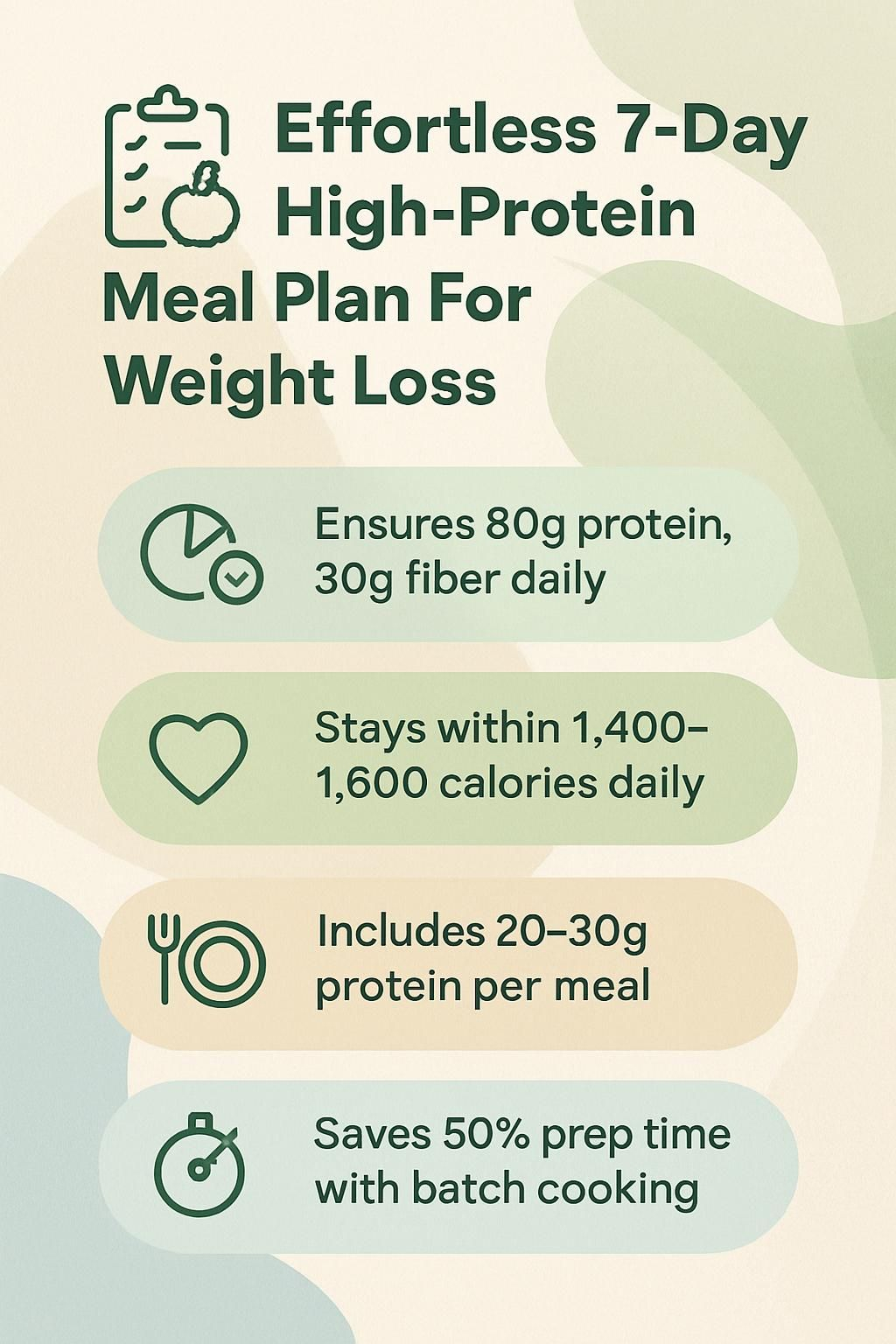
Why Choose a High-Protein Meal Plan for Weight Loss?
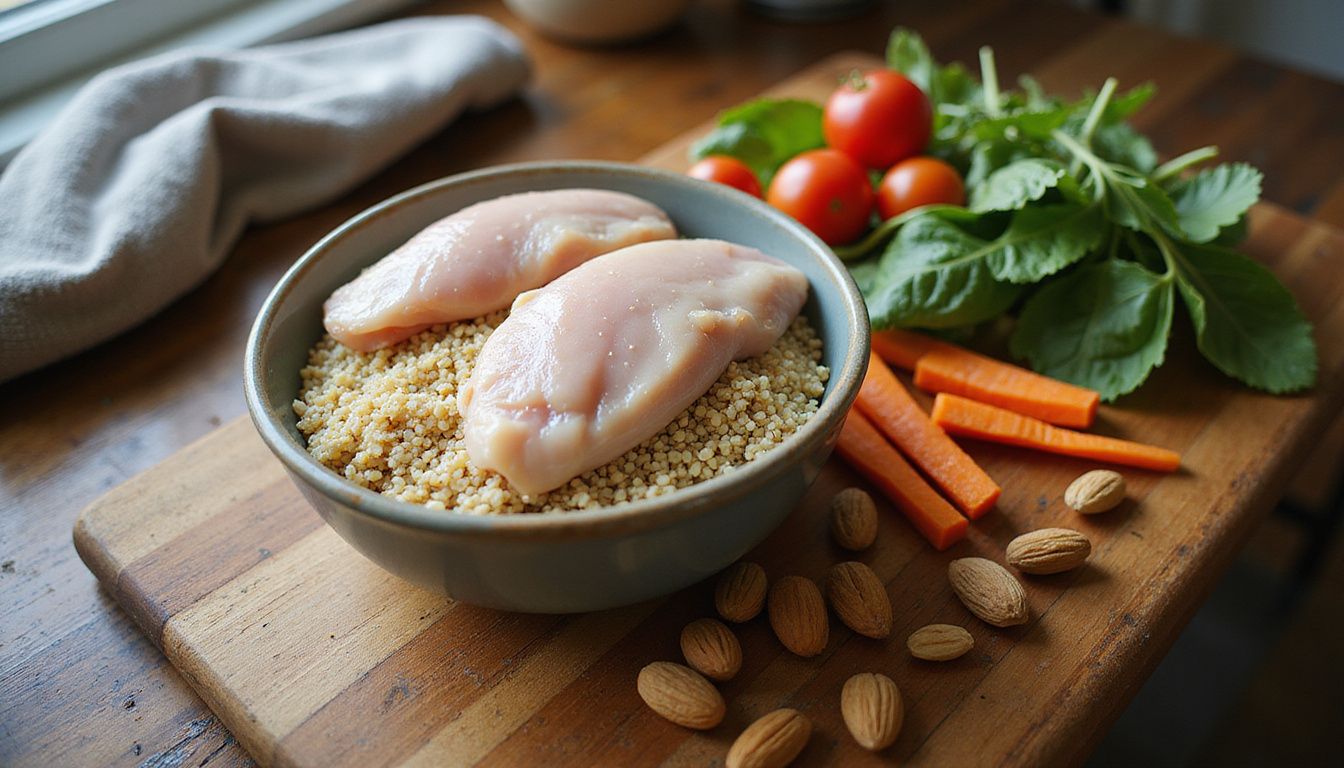
A high-protein approach helps you stay full longer and manage calories with less effort. Protein also preserves lean tissue during a calorie deficit. That means a healthier metabolism while you lose weight.
What are the benefits of protein for weight loss?
Protein helps you feel satisfied after meals. It slows digestion and reduces ghrelin, a hormone that triggers hunger. You also burn more calories digesting protein than carbs or fat. This is called the thermic effect of food.
- Fullness that lasts longer between meals
- More calories burned during digestion
- Better blood sugar control when paired with fiber
Studies show at least 80 grams of protein per day can support fat loss while keeping muscle. Pair protein with fiber-rich foods like oats, beans, and vegetables to reduce energy crashes. When I tried a 7-day high-protein plan from a dietitian, cravings dropped fast and my energy rose, even with fewer calories.
Choose quality sources such as lean meat, beans, eggs, dairy, tofu, or fish. These options make a protein diet meal plan easier to follow and sustain.
How does protein help maintain muscle mass?
Muscles need amino acids, the building blocks found in protein, to repair and grow. During weight loss, protein limits muscle breakdown and supports strength.
Good options include chicken, fish, eggs, beans like chickpeas and soybeans, strained yogurt, cottage cheese, and nuts. The 2020-2025 Dietary Guidelines for Americans suggest at least 0.8 grams of protein per kilogram of body weight daily. Many active people need more to maintain lean mass.
High-protein meals help you stay full and keep energy steady during this seven-day meal plan.
How This 7-Day Meal Plan Works
This plan balances calories, protein, fiber, and healthy fats so you can lose weight without guesswork. Each day targets at least 80 grams of protein and 30 grams of fiber for satiety and health.
What are the daily calorie goals?
Most adults aiming for weight loss do well at 1,400 to 1,600 calories per day. Needs vary by age, sex, activity, and current weight. This high-protein meal plan was created by a dietitian to fit that range and support steady progress.
Each day provides at least 80 grams of protein and 30 grams of dietary fiber. Protein maintains muscle, and fiber supports fullness and digestion. If you need more or fewer calories, adjust portions or swap a snack while tracking intake. I felt more energized during the week, especially when I added a brisk walk.
How is protein, fiber, and nutrients balanced?
Meals use lean meat, legumes, seeds, and dairy to hit your protein goals. Breakfast, lunch, and dinner aim for 25 to 35 grams of protein each. Whole grains and colorful produce add fiber, vitamins, and minerals that support long-term health.
- Protein: 80 to 110 grams per day, about 25 to 35 grams per meal
- Fiber: 30 grams or more per day from grains, beans, fruits, and vegetables
- Calories: about 1,400 to 1,600 per day for most adults
Olive oil, nuts, and seeds provide healthy fats. This balance helps reduce hunger between meals and supports heart health.
General advice only. If you have a medical condition, are pregnant, or take medications, talk with a healthcare professional or registered dietitian before changing your diet.
Day 1: Meal Plan
Day 1 keeps things simple with high-protein staples and fresh produce. Prepare extra servings to make tomorrow easier.
What should I eat for breakfast on Day 1?
Start with strained yogurt topped with berries and one tablespoon of honey. Add two boiled eggs for more protein. Pair with one slice of whole grain toast and a small glass of low-fat milk.
This breakfast provides protein, fiber, and calcium for a strong start. The yogurt and eggs support muscle. Berries add antioxidants, and the toast gives long-lasting energy. For a bigger boost, mix one scoop of protein powder into the yogurt.
What is a good morning snack for Day 1?
If hunger returns mid-morning, have strained yogurt with one cup of berries. You get about 15 grams of protein, fewer than 150 calories, and plenty of vitamins.
Yogurt helps you stay full, and berries add natural sweetness. I often rely on this snack on busy days. A pinch of cinnamon adds flavor without extra sugar.
What lunch options are included on Day 1?
Enjoy grilled chicken with quinoa and roasted broccoli. Top the quinoa with cucumber, tomato, parsley, lemon juice, and a light drizzle of olive oil.
This meal has about 36 grams of protein and travels well. I often double the chicken for easy leftovers. Extra vegetables add fiber and nutrients without many calories.
What dinner is planned for Day 1?
Bake lemon garlic chicken and serve with roasted zucchini and bell pepper. Add a half cup of brown rice for more fiber.
Each serving provides about 30 grams of protein and under 400 calories. The vegetables add fiber and a variety of vitamins. Simple seasonings like garlic, lemon, salt, pepper, and herbs keep prep fast and flavor high.
Day 2: Meal Plan
Day 2 continues the 7-day high-protein meal plan with simple, tasty choices that meet your nutrition goals.
What should I eat for breakfast on Day 2?
Build a strained yogurt parfait with mixed berries and chia seeds. Add a small handful of nuts for crunch and healthy fat. Pair with a slice of whole grain toast spread with peanut butter.
This combination delivers more than 20 grams of protein and supports steady energy. Breakfasts that include at least 15 grams of protein often reduce hunger later in the day.
What is a good morning snack for Day 2?
Have strained yogurt with berries and a tablespoon of nuts. You get about 15 grams of protein plus healthy fats and antioxidants. Portion it the night before for fast grab-and-go.
If you want more flavor, add cinnamon or a small drizzle of honey without raising calories much.
What lunch options are included on Day 2?
Grilled chicken with roasted vegetables forms a filling lunch. Add a whole grain like quinoa or brown rice for extra plant-based protein and slow-digesting carbs.
Include a side salad with spinach and edamame or avocado. A light vinaigrette adds taste without many calories. Expect over 30 grams of protein and at least 8 grams of fiber.
What dinner is planned for Day 2?
Bake skinless chicken with herbs and lemon juice. Serve with roasted broccoli and whole grain couscous.
This dinner gives about 35 grams of protein and supports muscle during weight loss. Add a small serving of strained yogurt with berries for dessert if you want something lightly sweet.
Day 3: Meal Plan
Day 3 introduces new flavors while keeping protein high. Variety helps you stay consistent all week.
What should I eat for breakfast on Day 3?
Scramble two eggs with spinach and top with sliced avocado. Add a slice of whole grain toast.
Blend a small berry smoothie with strained yogurt, a small banana, and chia seeds if you need more protein. This breakfast supplies about 25 to 30 grams of protein and helpful fiber.
What is a good morning snack for Day 3?
Plain strained yogurt with chopped nuts makes a strong snack. One cup offers 15 to 20 grams of protein. Nuts add texture and healthy fats that help you feel satisfied.
Top with blueberries or strawberries for natural sweetness and extra fiber. I pack this in small containers the night before and grab it on my way out.
What lunch options are included on Day 3?
Grilled chicken breast with a quinoa salad is the base for lunch. Add cherry tomatoes, cucumbers, and bell peppers. Toss with a light lemon vinaigrette.
Sprinkle a small handful of nuts for crunch. This meal delivers around 36 grams of protein and keeps you full, thanks to fiber from vegetables and whole grains.
What dinner is planned for Day 3?
Bake salmon and serve with roasted zucchini, tomatoes, and red onions. Add a side of quinoa.
Salmon offers more than 25 grams of protein per serving and reheats well. A squeeze of lemon and a drizzle of olive oil brighten the meal without much effort.
Day 4: Meal Plan
Day 4 keeps momentum with quick builds and bright flavors. A little prep tonight can ease tomorrow.
What should I eat for breakfast on Day 4?
Make a strained yogurt parfait with three-fourths cup yogurt, half cup berries, two tablespoons sliced nuts, and one tablespoon chia seeds. Expect about 20 grams of protein.
For more energy, add a slice of whole grain toast with a thin layer of peanut or almond butter. The mix of protein, fiber, and healthy fats keeps appetite steady until lunch.
What is a good morning snack for Day 4?
Choose strained yogurt topped with chopped nuts. You will get 15 to 20 grams of protein plus fats that support fullness.
I grab this often for a mid-morning lift. Add a few seeds or a small amount of low-sugar granola if you want extra crunch.
What lunch options are included on Day 4?
Pick a Tuna Salad Lettuce Wrap or a Grilled Chicken and Quinoa Bowl. For the wrap, mix canned tuna with a little light mayonnaise and chopped celery, then spoon into crisp romaine leaves.
For the bowl, combine grilled chicken breast, cooked quinoa, steamed broccoli, and diced bell peppers. Finish with a light vinaigrette or lemon. Both lunches land near 28 to 32 grams of protein and keep you satisfied.
What dinner is planned for Day 4?
Grill salmon and serve with roasted sweet potatoes and steamed green beans. You will get about 35 grams of protein per serving.
Salmon provides heart-friendly fats. Sweet potatoes and green beans add fiber for fullness. A quick stir fry of the beans with garlic and a little olive oil boosts flavor without many calories.
Day 5: Meal Plan
Day 5 adds easy comfort meals that still align with your calorie goals.
What should I eat for breakfast on Day 5?
Top strained yogurt with sliced nuts and fresh berries. Add a sprinkle of chia seeds. Serve with one slice of whole grain toast spread lightly with nut butter.
This breakfast offers about 24 grams of protein. Yogurt supports gut health, nuts provide healthy fats, and toast fuels your morning. It keeps my energy steady until lunch.
What is a good morning snack for Day 5?
Have strained yogurt with sliced nuts and blueberries. One cup gives about 17 grams of protein and helps with fullness.
Hard-boiled eggs or a small protein muffin made with oats and whey are other simple options. I keep a few boiled eggs in the fridge for fast snacks on busy days.
What lunch options are included on Day 5?
Make grilled chicken wraps with whole grain tortillas, mixed greens, tomatoes, and a light strained yogurt sauce. Add carrot sticks or cherry tomatoes on the side.
For a fish option, bake salmon and serve over brown rice with steamed broccoli. Both choices provide high-quality protein to support muscle during weight loss and aim for about 35 grams per meal.
What dinner is planned for Day 5?
Cook spaghetti with turkey meatballs. Use lean ground turkey and bake the meatballs to reduce calories. Serve with marinara sauce made from tomatoes, garlic, and herbs.
Add steamed broccoli or sautéed spinach for more fiber and nutrients. Expect about 30 grams of protein per serving. I like to batch-cook extra meatballs and freeze some for quick meals later.
Day 6: Meal Plan
Day 6 leans on baking and grilling to keep meals interesting and light. Adjust a snack or two if workouts raise your energy needs.
What should I eat for breakfast on Day 6?
Scramble eggs with spinach and a small amount of low-fat feta. Add one slice of whole grain toast for fiber and steady energy.
One serving delivers about 20 grams of protein. Research suggests 20 to 30 grams at breakfast may support weight management and muscle maintenance.^1 If adjusting calories, change toppings or portion sizes. Grilling vegetables instead of sautéing can lower calories and keep flavor.
…
^1: Leidy HJ et al., “The Role of Protein in Weight Loss and Maintenance,” The American Journal of Clinical Nutrition, 2015;101(6):1320S-1329S.
What is a good morning snack for Day 6?
Strained yogurt with a small handful of almonds is a strong choice. One cup of yogurt provides about 16 grams of protein, and 12 almonds add about 3 grams.
This snack supports fullness and muscle as you work toward your goals. I like it after a morning walk because it delivers steady energy until lunch.
What lunch options are included on Day 6?
Make a grilled chicken and quinoa salad with spinach, cherry tomatoes, cucumbers, lemon juice, and a little olive oil. This meal has about 400 calories and 35 grams of protein.
Add a boiled egg if you need a boost. Prepping extra salad in advance can reduce midday cravings and keep energy stable.
What dinner is planned for Day 6?
Bake salmon and serve with steamed broccoli and roasted sweet potatoes. Three ounces of cooked salmon gives about 22 grams of protein plus omega-3 fats for heart health.
For a plant-based option, try a lentil and vegetable stir-fry with brown rice. One cooked cup of lentils supplies about 18 grams of protein. I often prep this meal ahead, and it reheats well after a long day.
Day 7: Meal Plan
Day 7 brings it all together so you finish the week confident and prepared.
What should I eat for breakfast on Day 7?
Strained yogurt with sliced strawberries and chia seeds offers about 20 grams of protein. Add a slice of whole grain toast with almond butter.
Starting your day with at least 20 grams of protein can reduce hunger later. This breakfast kept me full for hours and helped curb cravings.
What is a good morning snack for Day 7?
Low-fat cottage cheese with pineapple is a quick, satisfying snack. Half a cup provides about 14 grams of protein. Pineapple adds vitamin C with few calories.
Pack it in a small container for on-the-go days. A handful of nuts adds more protein and healthy fat for steady energy.
What lunch options are included on Day 7?
Have grilled chicken over a spinach and quinoa salad with cherry tomatoes and cucumbers. Dress with a little olive oil and lemon.
Each serving offers about 35 grams of protein and keeps calories in check. Prepping chicken the night before saves time. If you prefer a plant-based lunch, swap in roasted chickpeas for a similar protein boost.
What dinner is planned for Day 7?
Grill skinless chicken breast and serve with roasted Brussels sprouts and quinoa. The vegetables and grain add fiber that helps you stay full through the evening.
Use olive oil lightly on the sprouts, and season with lemon or herbs. Expect more than 35 grams of protein while staying under 600 calories.
Meal Prep Tips for Success
Smart prep makes healthy eating easier on busy days. A little planning now saves time and reduces stress later.
How can I prepare ingredients ahead of time?
Wash and chop vegetables, then store them in airtight containers. Cook lean proteins such as chicken breast, tofu, or hard-boiled eggs. Portion them for quick use.
Pre-measure snacks like strained yogurt, cottage cheese, or unsalted nuts into grab-and-go containers. Cook brown rice or quinoa in bulk and refrigerate for up to four days.
Batch-cooking can cut prep time by about half. Laying out ingredients before cooking speeds things up as well. Use a digital scale if you want precise portions, and label containers with dates for freshness and safety.
How do I use leftovers effectively?
Store extra cooked protein in airtight containers for salads, wraps, or stir-fries the next day. Mix leftover roasted vegetables into scrambled eggs at breakfast or toss with quinoa for lunch.
Plan meals that share ingredients. Use brown rice from dinner as the base for tomorrow’s bowl. Freeze single portions if you will not eat them within two days. Rotate items so the oldest gets used first. This routine prevents waste and supports portion control.
Additional Tips for Sustainable Weight Loss
A few steady habits can make this high-protein plan easier to maintain week after week.
Why is staying hydrated important?
Drinking enough water can help your body burn fat and control appetite. Even mild dehydration can slow metabolism. Hydration also reduces the chance of mistaking thirst for hunger.
I carried a reusable bottle during work and noticed fewer afternoon cravings. Energy and mood improved as well.
How can I incorporate exercise into my routine?
Start with activities you enjoy. Aim for at least 150 minutes of moderate activity each week, such as 30 minutes of brisk walking on five days. Split sessions into shorter blocks if needed.
Try bodyweight moves like squats or push-ups. Add resistance bands or light weights to build muscle. Set calendar reminders, invite a friend, and track progress with a simple log. Small actions like taking stairs or parking farther away also add up.
How should I adjust portions based on my needs?
Your calorie needs depend on age, gender, weight, height, and activity. Use tools like USDA MyPlate or a calculator to estimate a daily target. Measure food with a scale or cups for better accuracy.
If progress slows, reduce portion sizes. If energy dips, first add a bit more protein from chicken breast, strained yogurt, or eggs. Pay attention to hunger cues, and stop when satisfied instead of stuffed.
Conclusion
This effortless 7-day high-protein meal plan offers a simple path to weight loss. Each day balances protein, fiber, and calories so you feel full, protect muscle, and stay on track. Clear recipes and smart prep make the week easier, even when life gets busy.
High-protein foods support steady energy and fewer cravings. Use these strategies with your healthcare provider’s guidance if needed. Small, consistent choices build momentum you can maintain for the long term.
FAQs
1. What is a 7-day high-protein meal plan for weight loss?
A 7-day high-protein meal plan is a structured eating guide that focuses on foods rich in protein. This approach helps support muscle retention, reduces hunger, and may increase calorie burn. Research shows that higher protein intake can aid in weight management and fat loss.
2. How much protein should I eat each day on this plan?
Most evidence suggests adults aiming for weight loss should consume about 0.6 to 0.8 grams of protein per pound of body weight daily. For example, a person weighing 150 pounds would need about 90 to 120 grams of protein each day. This range supports muscle health while promoting fat loss.
3. Can I follow this meal plan if I have dietary restrictions?
Yes, you can adapt the meal plan to fit most dietary needs. For example, plant-based eaters can use beans, tofu, or lentils as main protein sources. Those with dairy or gluten sensitivities can choose alternatives like lactose-free yogurt or gluten-free grains. Always check with a healthcare provider before making major changes.
4. What results can I expect from a week on this meal plan?
Many people notice reduced cravings and better portion control within the first week. Studies show that high-protein diets help preserve lean tissue during weight loss and may lead to greater fat reduction compared to lower-protein diets. Personal experience supports these findings; after following such a plan, I felt fuller between meals and saw steady progress on the scale.
Summary: A 7-day high-protein meal plan uses evidence-based guidelines to support weight loss by increasing daily protein intake. The approach is flexible for different dietary needs and is backed by research showing benefits for appetite control and fat loss.

